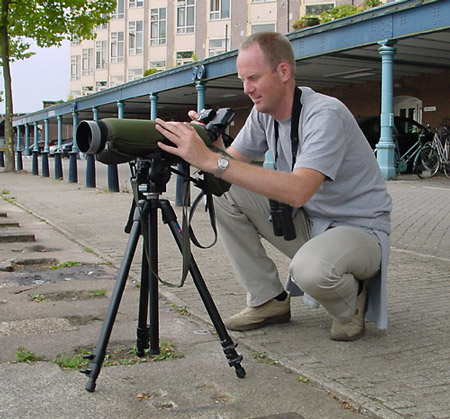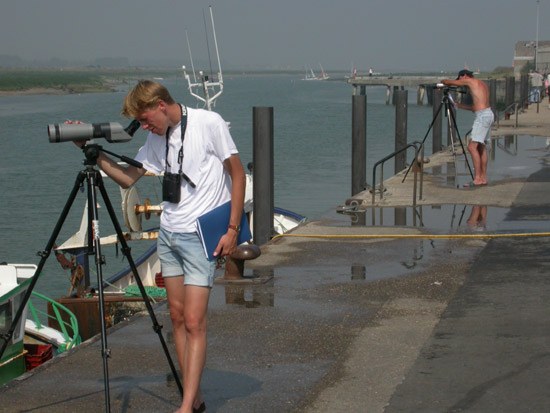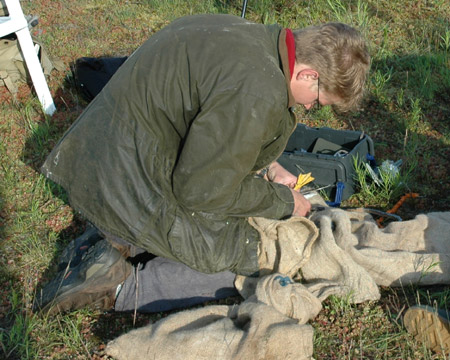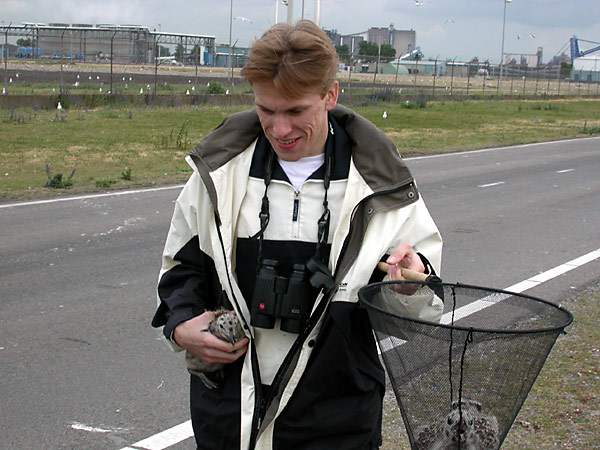 Gull
Research Organisation
Gull
Research Organisation
(last update: 04 oktober 2005)
|
|
Cooperation
in
In
the late 1990’s, three bird-watchers in the
These
three gull enthusiasts soon cooperated in their studies. Preliminary
results were discussed, research goals were set and they elaborated long
nights on observation methods and statistical analyses. After many
evenings and night, with a bottle of red wine or a cold beer, they agreed
on a priority list of field researches, methods and measurements. In 1998
and 1999, much time was spent on observing Lesser Black-backed Gulls at
several locations along the Dutch coast: Mars at
|
|
By
autumn, resting groups were checked at Westkapelle. By that time, Pim Wolf
from
Launch
of Muusse’s Website in 2000
|
|
The quickly growing data from the late 1990’s on graellsii and intermedius Lesser Black-backed Gulls culminated in the “Muusse’s Website”. This website was launched in January 2000. The approach was unusual for that time, as gulls were dealt with by calendar year and in sub-section by season. Every section was richly illustrated with digital photographs, a novelty by that time. Specific paragraphs returned in every section, including ‘characteristics, ‘moult sequence and timing’, ‘migration’ and ‘tables’. These tables showed the research results and statistics in detail.
In
2000, more interest developed to study gulls abroad and in January 2000 armenicus
was studied in
Going
abroad in 2001
Almost
all months of 2001 were covered by observations of graellsii in the
|
|
Inspired
by the success of the visit to Le Portel, we planned more visits in 2001:
early May, late July, late September and early October. Interest in rare
gulls also led to a short trip to the Arabian peninsular, when Theo and
Mars Muusse studied and ringed barabensis,
cachinnans, fuscus and heuglini in
Focus
on ringed 2cy michahellis in 2002
|
|
Le
Portel proved to be essential for close range observations of michahellis and throughout 2002 we planned visits to get a
month-by-month coverage of michahellis:
January, April, May, June, July, September, early October and late
October. Some of the results of an identification article on 2cy michahellis were made public on the International Gull Meeting at
After collecting data on post-juvenile moult in michahellis, autumn 2002 a new research on that subject was set up and focussed on ringed birds only. Simultaneously, this research was done for post-juvenile moult in 1cy Herring Gulls.
|
|
By
2002, sufficient data were collected for regression analyses on primary
moult timing in 2cy herring gull, and research shifted to the partial
autumn moult in 2cy herring gull, a subject not described yet. The last
months of 2002 were spent in S France and
Finally,
December 2002 we get new support from
Ringed
adult graellsii in 2003
Ruud
just joint the group when he visited
|
|
Two
researches continued: data collection for the post-juvenile moult research
in michahellis and the partial
autumn moult in 2cy argentatus.
November 2003 a special task force travelled to S France and
But
an intensive new study was started as well: numerous visits were paid
again to the colonies of Maasvlakte and Dintelhaven to score adult graellsii on primary moult commencement. We also visited the
relatively new colony of
All
data were quickly analysed and put on the Birdsnaps website. We realised
it would be better to first publish such data in magazines and it was
agreed to withdraw the site. Chris Gibbins came to the
Ringing
graellsii chicks in 2004
January
2004 just started when Ruud again visited Lubna dump in
|
|
This
year, we continued to set up new researches, as we started a very
intensive study on post-juvenile moult in graellsii at Maasvlakte.
Over 200 chicks were ringed, measured, photographed and videoed, in
cooperation with Norman van Swelm of the Bird Observatory Oostvoorne.
Summer 2004 we finally put all information together on pre-breeding moult
in 3cy graellsii and an article
on this subject was published in Birding World in 2005.
Ringing
adult graellsii in 2005
In
2005, ORG saw a new member again. Roland-Jan Buijs had been ringing adult
and juvenile graellsii and argenteus
at Moerdijk for several years. Theo contributed in this research and
suggested data collection on moult and phenotypic characteristics.
Roland-Jan and Theo published their data on the Bruxelles Colour-ring
Meeting. Summer 2005, the first ORG article was published in Birding
World.
|
|
ORG:
a new approach to gull research
From
the very start of ORG, much emphasis was laid on descriptions of moult
stage, timing and sequences. In the late 1990’s, this resulted in a
feather-by-feather observation and score in gulls, and we do remember
afternoon score sessions in the Etaples harbour, NW France, taking six
hours or more in which we managed to describe just about 18 or 20 birds,
especially when dealing with mid-summer 2cy michahellis.
Most observers may feel it ridiculous to spend so much time describing
such a small sample, and score every feather even if a bird is sleeping
for a while. Nonetheless, these scoring sessions, in which feather tracts
are divided in many sub-divisions have learned us a lot about moult timing
and sequences and we believe introduced a new approach to gull-watching.
In our approach, the scapular region is not a uniform area of feathers,
but consists of small upper scapulars (
From
1999 onwards, most moult scores were supported by digital photographs, and
up to 2005, we took over 75.000 images of gulls in only six years.
|
|
Systematically
scoring soon developed in detailed descriptions of moult amongst several
gull taxa. However, it was difficult to make firm statements as origin and
exact age could not be proven, and therefore we strongly focus on ringed
birds nowadays. We also introduced standard colour scales and measurements
for statistical analyses. This proved to be of great help and analyses can
be executed fairly easily in Adobe Photoshop.
One
of the first goals to achieve was simultaneous gull counts throughout
The
idea has been tested only twice: to score second generation scapulars in
Herring Gull in autumn 2002 and to score primary moult in 2cy michahellis in













